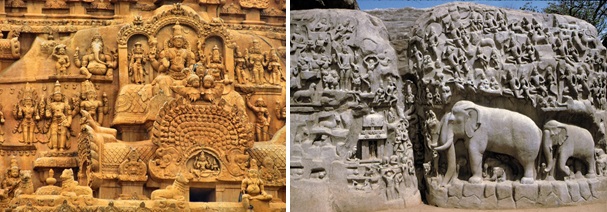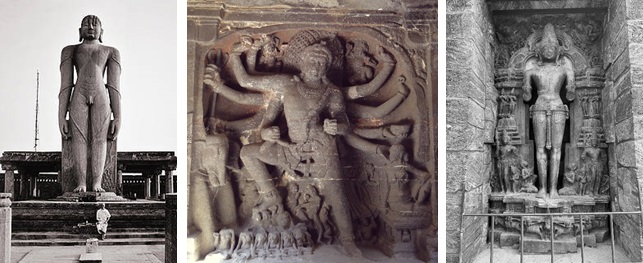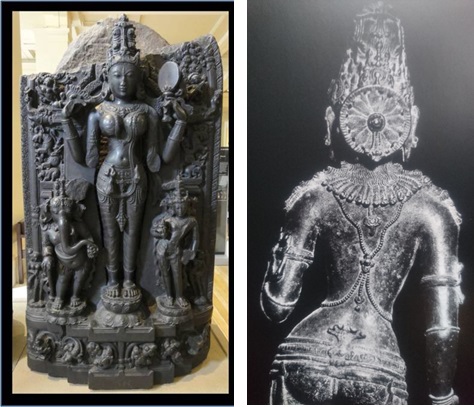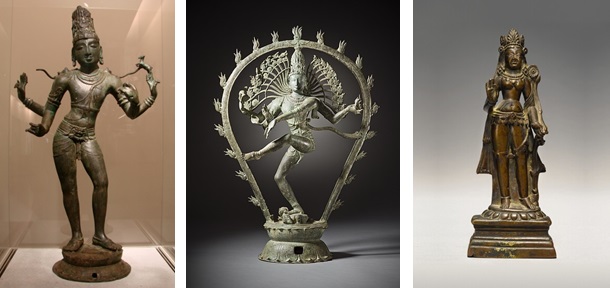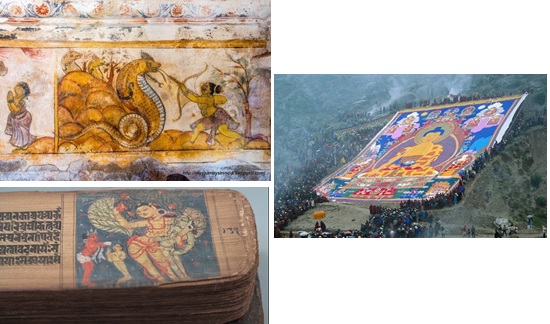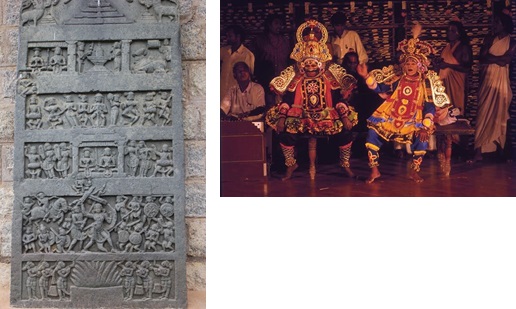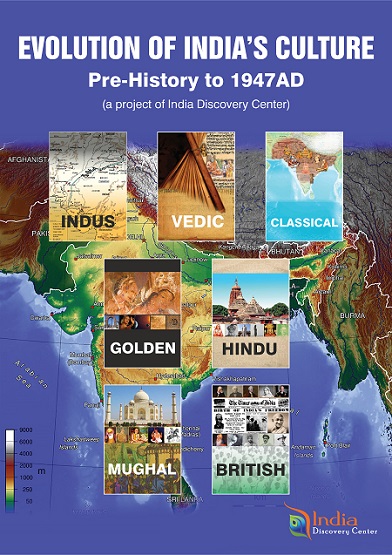India Hindu Period (500CE-1500CE) – Art and Culture
In the aftermath of the fall of the imperial Guptas, numerous powerful clans continually rose to power and declined in various parts of India. (Ref1) Resultantly there was a decline of the great city-centre and a rise of numerous mid-sized towns and villages reducing the stark difference in living conditions between the fortified cities and bucolic villages. To establish legitimacy, each ruling clan associated themselves with different icons of the Hindu pantheon like Shiva, Shakti, Vishnu, Surya, Ganesha, Kartikeya etc presenting the icons as the ‘presiding deity’ of their kingdoms. With continued patronage to these icons, society also turned deeply religious, casting aside the former ‘Nagarika’ styled ‘artistic’ lifestyle and welcoming a tradition of ‘pious devotion’. The expression of art and cultural activities too moved away from a ‘man’s entertainment’ to ‘creating a heavenly atmosphere’ for the Gods on earth.
To bring the Gods down to earth and help meet the common man, this period stands apart from all others for the magnificent rock cut and stone masonry temples all over India built by different ruling clans that stand majestically till date. Among the main cluster of these astoundingly beautiful rock cut temples, the Kailashnath temple of Ellora is considered the pinnacle of engineering and sculptural mastery. (Ref2) These also started the practice of massive and highly ornate ‘shikharas’ (towers) atop the main sanctum, emulating ‘a heavenly palace floating in the clouds’ . The Indian treatise of architecture ‘Shilpa shastra’ enumerates 3 main styles, Nagara (North Indian), Dravida (South Indian) and Besara (mixed) shikharas.(Ref3). The temples are intricately and ornately carved both in the inside and outside.
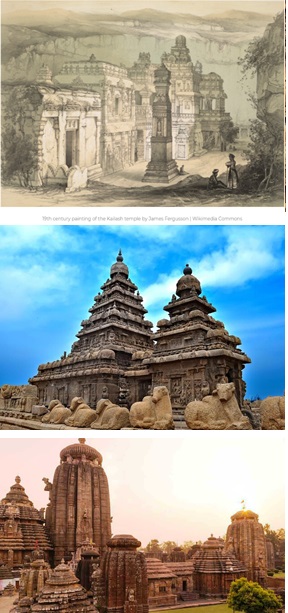
Fig1. Kailash Temple, Ellora. Shore Temple, Mammalapuram (Dravida shikhara). Lingaraj Temple, Bhubaneshwar (Nagara Shikhara)
Fig2. Sculpture- Brihadishwar Temple (Tanjavur) and Mammalapuram (Arjuna’s penance)
Fig.3. Bahubali at Shravanabelagola. Shiva at Kailash temple, Ellora. Surya at Konark.
As alluded, all these temples are dedicated specifically to one or more icons of the Hindu pantheon. Hence post Gupta, we observe the rise of the defined anthropomorphic manifestations of these icons along with Buddha and Jaina Tirthankaras, as rock cut sculptures along the walls of the caves, temples, and their facades, as well as stand free standing sculptures in the sanctum (embellished with precious jewels). (Ref4) Various scenes from puranic or jataka stories are also found etched on the walls like friezes. A lot of these were covered in gold leaf or painted over. The Chinese traveler Hiuen Tsang's description of the erstwhile Sun Temple in present day Multan describes a free-standing gold idol of Surya with jewels for eyes.
Fig4. Lalita flanked by Kartikeya and Ganesha, Pala (North). Headdress of Uma, Chola (South)
Fig5. Shiva playing damaru, Chola Bronze. 10th Cent. Copper alloy Nataraja. 9th cent. Copper alloy Tara with silver inlay, Kashmir.
Arguably, this period also pioneered in producing idols of the Hindu (including Tantric), Buddhist and Jaina icons in several metal and metal alloys, notably the Ashta-Dhatu (8 alloy mix) idols popularised by Palas in North and Bronzes of the Cholas in South. These are still prolific in India varying from a few centimeters to several feet in size, in temples and regularly passed through families as family deities. The most recognisable is undoubtedly the ‘Nataraj’ iconography of Shiva as the cosmic dancer (Chola Bronze). The mixed alloy icons were specially favoured for their polished gold like shine and jewel toned painted decorative ornaments.
Painting styles of the period are observable from the colorful murals depicting the deities, puranic stories, the patron kings, their families, and entourage in the interiors of the temples. The sanctums were decorated with gold, silver, and precious jewels, much like opulent Indian temples today. Besides, handwritten palm leaf manuscripts that had already been in production for several centuries, began to be heavily embellished with paintings using natural pigments (iconography and decorations) first by Jain manuscript makers, an idea later observed in Buddhist manuscripts too. (Ref 5) Massive decorated ritual paintings of Bodhisattva (Thangka) also originated from this period.
Fig 6. Murals Brihadishwara Temple. Illustrated original Ashtadashsahasrika Prajyaparamita.
Ceremonial Thangka, Tibet.
Fig.7 Natmandapa (dance hall) flanked by female musicians on walls of Konark, Orissa.
Music and dance flourished but like all other forms of art, was directed heavily towards pleasing the deities (and devotees) and increasingly attached to the temples. Most of the larger temples have a ‘Natya mandapa’ (dance hall) attached to it (built within the original plan with similar detailing) where regular dance and music performances were held as a part of daily rituals. As the idea of ‘sovereignty’ shifted from the ruling King to the presiding deity, it was considered necessary to hold opulent entertainment for the deity in the temples. Though Harshavardhana, is known to have written several sanskrit plays early during the period, Sanskrit theatre observably suffered a decline, probably due to its inherently secular themes, but theatre, dance dramas and puppetry survived in folk forms. (Ref 6)
Fig.8 Memorial Hero-stone, 11th century, Karnataka. Therukottoo, Tamil Nadu.
Regional literature in vernacular languages received heavy patronage, but their subjects were either religious or records of feats of the patron royalty. Nevertheless, they nourished the development of vernacular languages, stories and scripts. They also helped immortalise fables of folk heroes and heroines, who died defending villages, and were commemorated with small ‘Hero stones’ still found all over South India.
Ref :
1. Famous ruling clans: Chola, Chalukya, Pallava, Rashtrakuta, Pala, Sena, Chandella, Vakatakas etc
2. Main cluster of Rock cut temples: Shore Temples and Rathas of Mammalapuram, Brihadishwara (Tanjavur), Virupaksha (Pattadakal), Hoysaleshvara(Halebid), Kailashnath(Kanchi), Surya Temple (Konarak), Lingaraja and Jagannatha (Puri), Kandariya Mahadeva (Khajuraho cluster) of Hindu pantheon as well as Jaina temples (Mt. Abu)
3. The Nagara style characterized by a square base with graduated projections of each side, the latter (projections) being continued (almost appearing indefinitely) in the Shikhara, which tapers in at the top giving an elongated half oval shape. The Dravidian style in contrast is marked by the base having more than 4 sides and a distinct pyramidal shaped shikhara (Vimana) with a heavy lodestone at the very top. Besara is a mixed style.
4. Hindu Pantheon (of the Period): Shiva, Parvati, (Uma-Maheshwara), Vishnu, Surya, Ganesha, Ganga, Yamuna, Lakshmi, dwarapalakas). Buddhist pantheon: Buddha, Tathagatas, Bodhisattvas (including Avalokiteshwara, Maitreya, Tara, Manjushri, Prajnaparamita). Jaina pantheon: 24 Tirthankaras, Bahubali etc)
5. Painted manuscripts: Jain Kalpasutras, Pala- Ashatadashshasrika Prajnaparamita
6. Folk theatres: predecessors of Chhau, Yakshagana, Therukottoo, Ramlila etc.
Picture sources :
References :
1. A History of Ancient and Medieval India. Upinder Singh. 2018 impression.
2. The Wonder that was India. A.L. Basham. 3rd edition.
3. The Civilization of India. R.C. Dutt.1995
4. The archeology of early historic South Asia. F.R Allchen. 1995.
5. Ancient Indian and Indo-Greek theatre. M L Varadpande. 1981
6. Shilpe Bharat o Bohirbharat (Bengali). Manindrabhushan Gupta. 1995.
7. A Cultural History of India. A.L. Basham. 1975
8. Foreign Influence on Ancient India. K.C. Sagar. 1992.
9. Cultural History of India.OM Prakash. 2004
10. https://www.amarsingha.org/2019/02/16/the-values-of-manuscript-art-part-2/
11. https://www.esamskriti.com/e/Culture/Indian-Culture/South-Indian-Bronzes~-Masterpieces-of-Indian-Art-1.aspx
______________________________________________________
Dr. Krishnakali Dasgupta leads the Art and Culture track in India Discovery Center's project on "Evolution of Indian Culture: Pre-history to 1947AD"
More information and updates on the project are available at
https://www.facebook.com/Evolution-of-Indian-Culture-An-IDC-Project-107749391111922
More information on India Discovery Center is available at https://www.indiadiscoverycenter.org
(c) Copyright 2021 India Discovery Center, Inc. All rights reserved.

